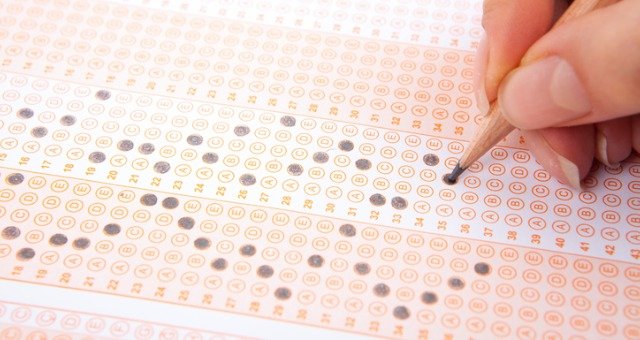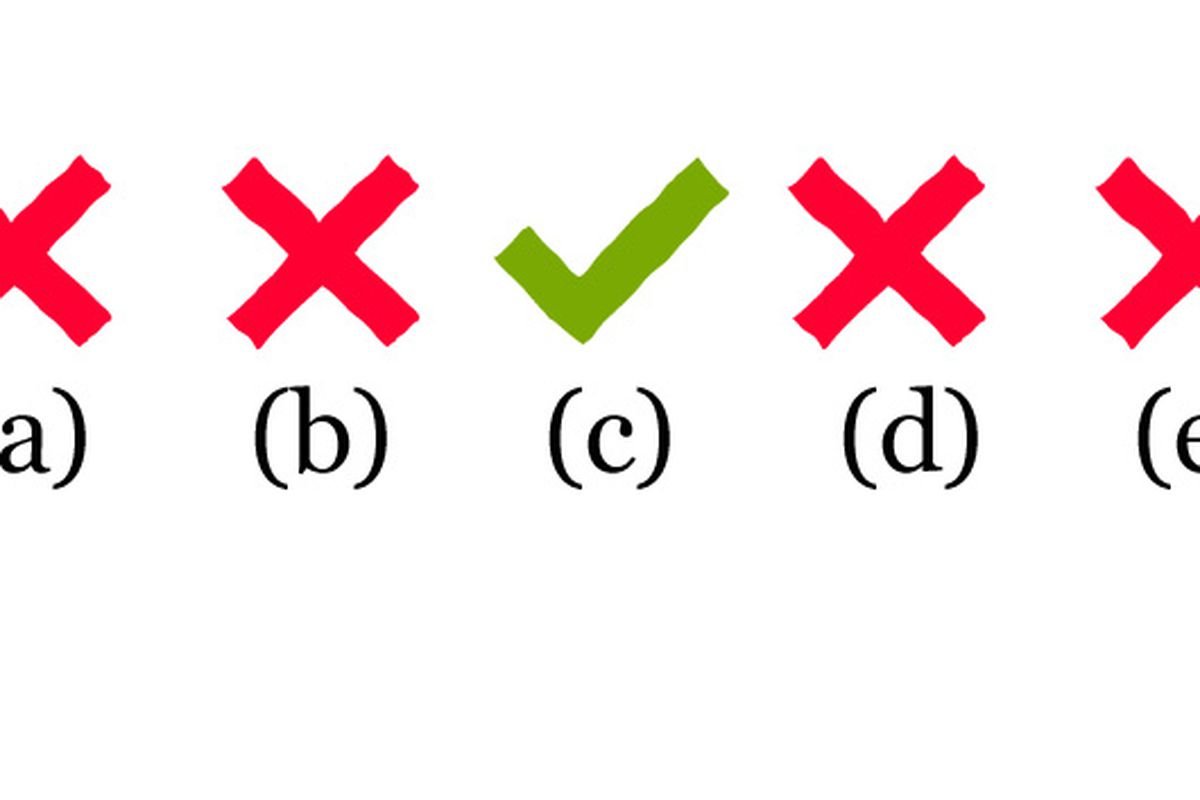OPINION: Tips and tricks to nail that 1600 SAT score
By Thea Kapteyn ‘23
Multiple choice test. Image courtesy of facultyfocus.com
Congratulations! If you’re reading this article, it probably means you care about doing well on the SAT. You may be taking your first steps into the world of standardized testing, or have the test scheduled for next weekend.
Either way, you have come to the right place. Below, you will find an assortment of tips and tricks from the experiences of three Catlin Gabel School (CGS) students, geared towards improving your performance on the SAT.
Remember, the SAT is not a measure of your ability as a student, scholastic aptitude, future success, or self-worth. The SAT is designed to test your ability to prepare for the SAT, and with the proper instruction, most students can achieve an ideal score.
Breakdown
The SAT is a three hour affair with a total of four sections:
Section 1: Reading (65 minutes, 52 questions)
Section 2: Writing and Language (35 minutes, 44 questions)
Section 3: Math No Calculator (25 minutes, 20 questions)
Section 4: Math With Calculator (55 minutes, 38 questions)
All sections on the SAT consist entirely of multiple choice questions with the exception of a few student produced responses at the end of both math sections. The math no calculator and math with calculator sections include five and eight student produced responses, respectively.
During the final 20 minutes of the test, you may have to fill out a fifth section. The subject of the fifth section (reading, writing, or math) is selected at random and you will be made aware of which one you have in the test room. Now that you’re well versed with the format of the SAT, let’s get into it!
CollegeBoard SAT. Image courtesy of fvhs.com
Guess! Guess! Guess!
In the case that you are crunched for time or are unsure of an answer choice, fill in a bubble and move on. The SAT does not penalize you for incorrect answers, so take a guess instead of leaving an answer blank - it is possible you’ll pick up some extra points.
When guessing, remember to choose a letter of the day (LOTD) and stay consistent with your selected letter throughout the duration of the test. Statistically, if you use the LOTD method, on average for every four questions you guess, you’ll get at least one correct.
When compared to guessing randomly, the LOTD method increases your chances of guessing correctly and gaining points.
The Infamous Section Five
The fifth section often causes panic among test takers. “I freaked out when I took my SAT, because I had no idea what it was.” CGS senior Cynthia Yang said.
To put it simply, do not freak out. Now that you’re aware of its inclusion, the fifth section is a new 20 minute addition to the SAT, and is administered to randomly selected groups of students.
The fifth section tests one of four subjects: reading, writing and language, math with no calculator, or math with calculator.
Although it is still unclear whether the fifth section is used to compute scores, the College Board has released a statement on the section, stating “The SAT contains some questions that won’t be used to compute student scores.
These questions may appear in any section. To give students the extra time to answer more questions, the tests include a fifth section with regular and pretest questions.”
Despite the lack of clarity, it is thought that the fifth section is not a factor in student scores. “It does not count for your score, so you just do it even though the College Board is not clear at all.” CGS senior Ryan Jan said.
However, it is easy to get lost in the confusion of the fifth section’s purpose. “I’m pretty sure it doesn’t count at all, but at the time I had heard rumors. For example, if the fifth section was the math section, they would take it with your actual first reading section and choose one at random to use for your actual score.” Yang said.
There are many theories regarding the fifth section and its nature, but regardless, it remains a good idea for students to answer all questions on the fifth section to the fullest of their abilities.
Process of Elimination
On the SAT, there’s only one correct answer, meaning, “It’s not about finding the right answer per se, it’s about eliminating the wrong answers.” Jan explained. Three out of the four answers are incorrect in some way, no matter the magnitude.
Instead of searching for the correct answer, look for what makes an answer choice incorrect. If you find yourself thinking “well B kind of fits the question,” eliminate the answer choice.
The SAT is similar to a puzzle - as much as you want to solve it with pieces that almost fit, doing so never yields the correct picture. If even a small element of an answer choice renders it an awkward fit, it should be eliminated.
Process of elimination. Image courtesy of collegeandmagnolia.com
Selectively Annotate
Annotating is a powerful tool to enhance the reader’s understanding and ability to recall details. A close reading of SAT passages, if possible jotting down key words from each paragraph of the reading, can prove to be beneficial when answering summative questions
Yang stated, “I usually annotate for things like figurative language, literary devices, transition words like however, although, and but.”
Yang’s model of circling figurative language, literary devices, and transition words comes in handy when you’re attempting to pinpoint arguments, central ideas, and shifts in the focus of the reading.
While annotating can help retain information, annotate with moderation. There is no need to highlight or mark down the small details of every sentence, “I just read it and underline the key points.” Jan said.
Annotating every little detail would be a waste of time. Instead, approach the passage with a selective annotation game plan.
Timing
The SAT is notorious for its fast-paced nature, so without the proper timing, students often have difficulties finishing all sections thoroughly.
During the reading section, CGS senior Barrett Burnham suggests, “Read it through once without focusing on the actual questions, and then go look at the questions and try to find where they match up in the story.”
Burnham’s approach is a popular one, as it prioritizes understanding the reading without narrowing your scope by focusing on the questions. Jan described a contrary approach to the reading section, “You look at the questions first and you start to get what they’re asking for, and they’ll highlight what comes up.”
Burnham’s method is more efficient in that it affords the student a comparatively solid understanding of the passage’s content. However, that is not to say that Burnham’s method works best for everyone. Some students may find that reading the entirety of the passage takes too much time.
It’s tempting to lay back, take a sip of water, and relax with any extra time before a given section ends, but every minute counts.
“Going back and checking can be helpful,” said Yang. With any remaining time, work your way back through the questions, checking each one, especially those you felt unsure about.
To keep track of time, bring a watch to the testing site. Instead of wasting time searching the room’s clock, “I brought an analog watch.” Yang explained. When choosing a watch, refrain from bringing smartwatches or fitness trackers.
If a test proctor sees a student wearing a form of technology, they will be asked to remove it from their wrist during the duration of the test.
The only way to find what methods of saving time work best for you is through taking practice tests. To maximize your score, take as many practice tests as you can, the minimum being two or three before your next SAT.
Timing. Image courtesy of totalbalance.blog
In a Nutshell
“It’s easy to stress out about the SAT, but in the long run, it doesn’t matter. Plus you can take it several times and superscore if you want.” Yang remarked.
During COVID-19, colleges were forced to re-evaluate the importance of the SAT in measuring a student’s academic success.
As a result, the majority of universities across America have announced their commitment to remain test optional for the 2023-24 admissions cycle, and certain schools have eliminated the option to submit SAT scores altogether.
Although the SAT is losing its relevance in college admissions, a good score can serve as a tipping factor in your application. With the help of the given tips and tricks, you will be able to reach your target score.




